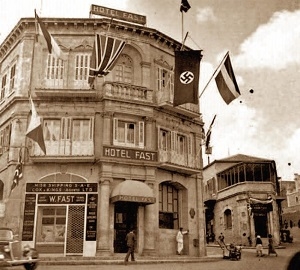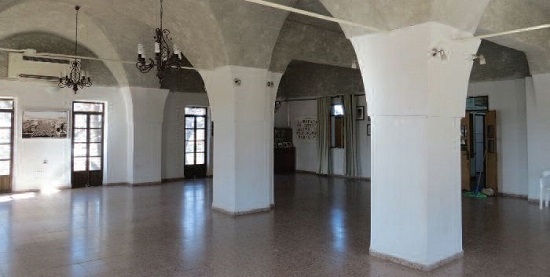Sarona, More than a Market
I joined the tour of Sarona organized by ESRA Kfar-Saba/Hod Hasharon outside the Visitors Center. We were guided through the Sarona-HaKiriya's mini-museum by Miki Cohen of The Council for Conservation of Heritage Sites in Israel. He gave us a very vivid outline of the site's saga - so vivid in fact that I did some research on my own, adding more to this fascinating history.
Templer Sarona
The Templers were a Protestant sect from Germany who believed in the apocalyptic prophecies of the Bible and decided to help in their fulfillment by settling in the Holy Land. From 1868 to 1907, they established eight communities in Ottoman Palestine, of which the best known are the German Colonies of Haifa and Jerusalem, Sarona, and Bethlehem of Galilee.
Sarona was the third colony and first agricultural community, founded in 1871 on the Jaffa-Nablus road. In the first few years, residents suffered hardship and loss because of unfamiliar agriculture, a harsh climate, disease and especially malaria: in 1872 there were 28 deaths out of a population of 125. Yet with time, innovation and perseverance, they began to prosper. In the coming decades, they also provided critical information and inspiration for the waves of Jewish settlement that began with Petah Tikva in 1878. Between 1909-38, a thriving dairy business supplied Tel Aviv with milk.
Under the British
Near the end of WWI in 1917, the British commandeered large parts of Sarona for military use, and in 1918 they deported 850 of an estimated total of 2,000 Templers from Palestine to an internment camp in Egypt, also seizing Templer holdings. Leaders of the Jewish Yishuv protested the deportations. In 1922, some 350 Templers were deported to Germany and the rest allowed to return to Palestine, where they took up their lives and ultimately received some compensation for damage and loss. Between 1922-28, the community again prospered; due to waves of Jewish immigration, its produce, trades and services were in ever increasing demand.
Sadly, with the rise of Hitler in 1932, the Nazi regime used financial pressures to force German groups abroad to align with Nazi ideals and use only Nazi approved personnel and curricula in education institutions. Though the older generation resisted and protested Nazi policy towards Jews, younger members were seduced by the nationalism, even establishing a branch of the insidious Hitlerjugend in Palestine. The Yishuv retaliated for Kristhallnacht by boycotting Templer products and businesses - a hard blow to Sarona's dairy industry. By 1938, some 17% of Templers were Nazi Party members; in August 1939, 232 young men - mostly Templers - left Palestine to join the Wermacht or SS, accompanied by 88 family members.
At the outbreak of WWII, British authorities arrested all Germans and other foreign nationals and turned Sarona into an internment camp housing some 1,000 people. In 1941, more than 600 Templers were deported to Australia, including 188 Sarona residents considered hard-core Nazi sympathizers. Over time, another 1,000 Templers were exchanged for 550 Jews trapped in Nazi controlled Europe.
The Irgun bombed Sarona's Templer meeting hall in 1943; the British removed the last Templers from the site in 1945 and Gotthilf Wagner, Sarona's last mayor and an SS Gruppenführer, was assassinated by the Haganah in 1946. For the Templers - and the British - the writing was on the wall.
During and after WWII, the area and buildings were mostly used as a British army camp and police base. In 1947, the British appropriated Templer lands as 'Enemy Property' and sold some of it to the Tel Aviv municipality, which had long sought to expand into the area. It was also the scene of the Jewish underground's first open act against the British.
The last Templers were evacuated to Germany and Australia just three weeks before the British Mandate in Palestine ended.
HaKiriya
The Haganah took over on December 16, 1947 and named it Camp Yehoshua. With Jerusalem under siege and the new Government of the State of Israel needing office space, Sarona became the temporary seat of government.
Because of the Holocaust and their Nazi associations, all Templers were banned from Israel and their property confiscated by Israel. However, they received full compensation when reparation agreements between Germany and Israel were finalized.
In keeping with this decision David Ben Gurion ordered that the name of the area be changed to HaKiriya (the Campus), and Tel Aviv be the provisional capital until Jerusalem was accessible again. The first stamps of the new state were printed in HaKirya by the Government Printing Office – set up in one of the wineries on a printing press brought by the Templers and taken over by the British.
Though Jerusalem was the capital, many ministries continued to operate out of HaKiriya, providing some nations with an oblique excuse not to recognize Jerusalem as such. The Army High Command, branches of the defense establishment, government and official bodies still linger in high-rise offices and in roughly half of the original area, now known as Camp Rabin, north of Kaplan Street. The camp looms large in the memories of those who served in the IDF - not least of all for a legendary sergeant-major, complete with swagger-stick and handlebar mustache, who made incoming personnel and uniformed visitors spruce-up if they did not pass inspection. He is commemorated with a near life-size placard and shoe-shine stand in the museum.
In 1978 the decision was taken to move all remaining government ministries to Jerusalem and planning began to convert the area into living, office and commercial properties. Initially, only five of the remaining Templer buildings were to be preserved, surrounded by high-rise construction. However, The Council for Conservation of Heritage Sites in Israel waged a determined, ten-year-long, hard-fought battle to conserve more of the site, with the final result that 37 of the original buildings were saved along with some of the original trees and gardens,including five buildings that had to be conserved and moved south when Kaplan Street was widened.
Of those buildings, 25 are in commercial use and 12 are earmarked as museums, with the famous Sarona Food Mall on the ground floor of one of the high-rise buildings bordering the museum-park complex. (In June 2016 there was a terror attack in the food market.) One entrance to the market is between the two original wineries... where Miki concluded our tour by walking us through the re-discovered tunnel that connects both wine cellars. The wineries are now restaurants with the cellars turned into spacious, high-end bars.
We broke for lunch. I settled for a kosher fish-and-chips shop on the side of the market facing the park. The food and house draft-beer were excellent and I was served by the proprietor, a new immigrant from France who had opened only five days earlier.
As I headed for the train station, I was delighted to see that the ugly olive-beige of Camp Rabin's landmark antenna-tower was streaked with red and blue paint graffiti – but how did they do it!
When I had time to absorb and review the information Miki had told and shown us as well as my own research, I understood why Sarona needed to be preserved. Though long gone, the Templers were critical to the early success of the Jewish Yishuv in Eretz Israel. They helped expand the tourist industry and inter-urban road network and established workshops, a foundry, a modern printing press and a bank. Their firsts in the Holy Land include:
* inventing the Jaffa Orange trademark
* employing an architect for urban and community planning
* planting eucalyptus trees to dry swampy ground and prevent the spread of malaria
* members contributing a fixed number of man-hours to community services
* introducing modern farming methods and implements
* introducing peaked, red-tile roofs to reduce heat, where flat or domed roofs had been the norm
* establishing two of the first modern wineries
* opening the first European-style outdoor café.
Somehow it is fitting that the first seat of our government should have been in the homes of those who worked so hard to renew the Land of Israel,but lost the right to share in the dream's fulfillment.
'Lest we forget...'
Historical trivia:
1936: Wilhelma Air Field is built and named for the nearby Templer community.
1943. Renamed RAF Station Lydda by the British, it is a major east-west stopover during WWII. 1948: Captured by Israel in the 1948 War of Independence and renamed Lod Airport. 1973: Renamed Ben Gurion International Airport in honor of Israel's first Prime Minister.
BTW: some of the original construction is still in use today.
For more on the Templers read www.esramagazine.com/blog/post/israel-sarona-tel-aviv-awakening.











Comments